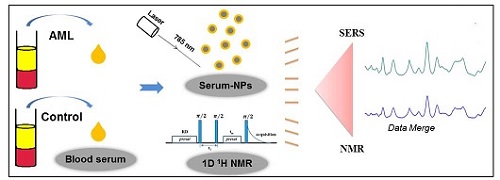
Contributions
Abstract: EP397
Type: E-Poster Presentation
Session title: Acute myeloid leukemia - Biology & Translational Research
Background
The proportion of adult non-M3 AML patients with poor prognosis is relatively large, which is mainly restricted by the current clinical detection limits and sensitivity. To explore new markers that can realize rapid screening and sensitive diagnosis of de novo non-M3 diagnosis of AML subtypes has important clinical significance.
Aims
The aim of this study is to explore serum-based markers in non-M3 AML patients after developing a synthetic approach on Ag nanoparticles-based surface-enhanced Raman spectroscopy (SERS) and non-targeted proton NMR metabolomics.
Methods
According to FAB classification, the serum samples were prepared from five types of non-M3 AML patients (including M0~M2, M4, and M5, n=50 for each type) and healthy controls (n=50, age and gender matched). The Ag substrate nanoparticle-serum complex was first prepared for SERS measurement. The serum metabolites were identified by 1D 1H NMR method. Statistical methods were utilized in unsupervised and supervised analyses. Both SERS band-intensity data and the metabolite-concentration data were set to merge in classification model for determination of relative diagnostic markers. The receiver operating characteristic (ROC) curves were used to assess the performance of these markers.
Results
We found significant changes in non-M3 AML patients with different subtypes. These appeared in tryptophan, serine, phenylalanine, proline and valine, as well as a variety of nucleic acid bases, phospholipids, D-mannose and collagen. These components were specifically characterized according to vibration mode due to their secondary structure. Several amino acids including tryptophan, serine, phenylalanine, proline and valine, as well as D-mannose were shared in serum metabolites analysis. These metabolites/components were shown to be the key to identify different AML subtypes. Further metabolic pathway analysis suggested disorders in multiple pathways, among which all five types can be separated when SERS and NMR data were set to merge for classification. Typically, the M5 AML was found to be abnormally active in glutathione metabolism, which may show some specificity for diagnosis, but its underlying mechanism still need to be addressed.

Conclusion
We have proposed the combined analysis of serum-based optics and metabolomics to provide rapid screening markers for AML patients with non-M3 diagnosis. It was also demonstrated that this method was of great value in clinical application with acceptable accuracy and good reproducibility.
Keyword(s): Acute myeloid leukemia, Nanoparticle
Abstract: EP397
Type: E-Poster Presentation
Session title: Acute myeloid leukemia - Biology & Translational Research
Background
The proportion of adult non-M3 AML patients with poor prognosis is relatively large, which is mainly restricted by the current clinical detection limits and sensitivity. To explore new markers that can realize rapid screening and sensitive diagnosis of de novo non-M3 diagnosis of AML subtypes has important clinical significance.
Aims
The aim of this study is to explore serum-based markers in non-M3 AML patients after developing a synthetic approach on Ag nanoparticles-based surface-enhanced Raman spectroscopy (SERS) and non-targeted proton NMR metabolomics.
Methods
According to FAB classification, the serum samples were prepared from five types of non-M3 AML patients (including M0~M2, M4, and M5, n=50 for each type) and healthy controls (n=50, age and gender matched). The Ag substrate nanoparticle-serum complex was first prepared for SERS measurement. The serum metabolites were identified by 1D 1H NMR method. Statistical methods were utilized in unsupervised and supervised analyses. Both SERS band-intensity data and the metabolite-concentration data were set to merge in classification model for determination of relative diagnostic markers. The receiver operating characteristic (ROC) curves were used to assess the performance of these markers.
Results
We found significant changes in non-M3 AML patients with different subtypes. These appeared in tryptophan, serine, phenylalanine, proline and valine, as well as a variety of nucleic acid bases, phospholipids, D-mannose and collagen. These components were specifically characterized according to vibration mode due to their secondary structure. Several amino acids including tryptophan, serine, phenylalanine, proline and valine, as well as D-mannose were shared in serum metabolites analysis. These metabolites/components were shown to be the key to identify different AML subtypes. Further metabolic pathway analysis suggested disorders in multiple pathways, among which all five types can be separated when SERS and NMR data were set to merge for classification. Typically, the M5 AML was found to be abnormally active in glutathione metabolism, which may show some specificity for diagnosis, but its underlying mechanism still need to be addressed.

Conclusion
We have proposed the combined analysis of serum-based optics and metabolomics to provide rapid screening markers for AML patients with non-M3 diagnosis. It was also demonstrated that this method was of great value in clinical application with acceptable accuracy and good reproducibility.
Keyword(s): Acute myeloid leukemia, Nanoparticle


